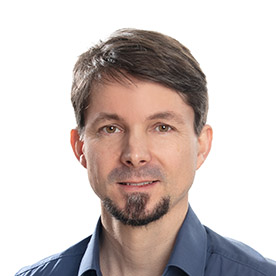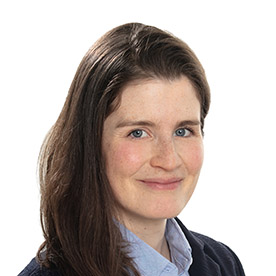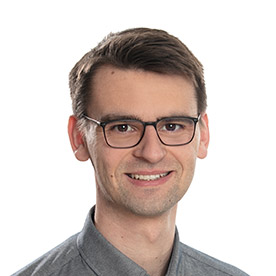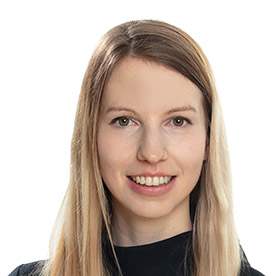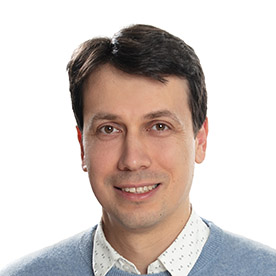OUR TEAM MEMBERS HAVE EXCELLENT
EXPERTISE IN MODELING & SIMULATION, ADVANCED ANALYTICS, AND DRUG DEVELOPMENT
We combine several decades of experience in the model-based and strategy-based support of drug development programs and general application of advanced analytics to inform decision making
Bio
Expert in Model-Informed Drug Development with cross-functional domain expertise supporting various therapeutic areas with over fifteen years of experience in the field. Professional experience includes assessing all available data and information within drug development projects (nonclinical, translational, early and late clinical, registration) in the context of the current drug development questions. Perform gap analyses, devise model based strategies to address key questions, select adequate methodological approaches, hands-on execution of analyses, supervision and mentoring of more junior modelers, and communication of results. Therapeutic area experience includes oncology, dermatology, immunology, infectious diseases, respiratory, gastrointestinal, bone and muscle wasting diseases. Pharmacometric experience includes (population) PK/PD, exposure-response, survival analysis, clinical trial simulations to assess certain metrics of interest (e.g., probability of success), complex mechanistic quantitative systems pharmacology models. Software and computational experience includes more than 18 years in the development of state-of-the-art software in support of efficient modeling and simulation across areas of Systems Biology, Quantitative Systems Pharmacology, and Pharmacometrics. These tools are key to allow focusing on the drug development question to address.
Journal Articles
Johnson, M., Kaschek, K., Ghiorghiu, D., Lanke, S., Miah, K., Schmidt, S., Mugundu, G. (2023) Population pharmacokinetic modelling of adavosertib (AZD1775) in patients with solid tumours, submitted to Clinical Pharmacokinetics.
Lill D., Kümmel A., Mitov V., Kaschek D., Gobeau N., Schmidt H., Timmer J. (2022) Efficient simulation of clinical target response surfaces. CPT Pharmacometrics and Systems Pharmacology 11 (4):512-523
Helmlinger, G. et al (2019) Quantitative Systems Pharmacology: An Exemplar Model Building Workflow with Applications in Metabolic, Cardiovascular, and Oncology Drug Development, CPT Pharmacometrics Syst Pharmacol., doi: 10.1002/psp4.12426.
Schmidt, H., Radivojevic, A. (2014) Enhancing population pharmacokinetic (popPK) modeling efficiency using an integrated workflow, Journal of Pharmacokinetics and Pharmacodynamics, invited paper, 41(4)
Hallow, K.M., et al. (2014) A model-based approach to investigating the pathophysiological mechanisms of hypertension and response to antihypertensive therapies: Extending the Guyton model, American Journal of Physiology, DOI: 10.1152/ajpregu.00039.2013
Sunnaker, M., Schmidt, H., Jirstrand, M., Cedersund, G. (2010) Zooming of states and parameters using a lumping approach including back-translation, BMC Systems Biology, 4(28)
Dell’Orco, D., Schmidt, H., Mariani, S, Fanelli, F. (2009) Network-level analysis of light adaptation in rod cells under normal and altered conditions, Molecular BioSystems, DOI: 10.1039/b908123b
Schmidt, H., Madsen, M., Danø, S., Cedersund, G. (2008) Complexity Reduction of Biochemical Rate Expressions, Bioinformatics, doi: 10.1093/bioinformatics/btn035
Dell’Orco, D., Schmidt, H. (2008) Mesoscopic Monte Carlo simulations of stochastic encounters between photoactivated rhodopsin and transducin in the ROS-disc membrane, Journal of Physical Chemistry, doi: 10.1021/jp709963f
Nedbal, L., Červený, J., Rascher, U., Schmidt, H. (2007) A modeling approach to understand chlorophyll fluorescence transients and complex dynamic features of photosynthesis in fluctuating light, Photosynthesis Research, 93, 223-234
Schmidt, H., Drews, G., Vera, J., Wolkenhauer, O. (2007) SBML Export Interface for the Systems Biology Toolbox for MATLAB, Bioinformatics, 23, 1297-1298
Schmidt, H. (2007) SBaddon: High Performance Simulation for the Systems Biology Toolbox for MATLAB, Bioinformatics, 23, 646-647
Danø, S., Madsen, M., Schmidt, H., Cedersund, G. (2006) Reduction of a biochemical model with preservation of its basic dynamic properties, FEBS Journal, 273, 4862-4877
Schmidt, H., Jirstrand, M., Wolkenhauer, O. (2006) Information Technology in Systems Biology, invited article for it–Information Technology, 48(3), 133-139
Schmidt, H., Jirstrand, M. (2006) Systems Biology Toolbox for MATLAB: A computational platform for research in Systems Biology, Bioinformatics, 22(4), 514-515
Ullah, M., Schmidt, H., Cho, K.-H., Wolkenhauer, O. (2006) Deterministic Modelling and Stochastic Simulation of Pathways using MATLAB, IEE Proceedings – Systems Biology, 153(2), 53-60
Schmidt, H., Jacobsen, E.W., Cho, K.-H. (2005) Identification of Small Scale Biochemical Networks Based on General Type System Perturbations, FEBS Journal, 272(9), 2141-2151
Schmidt, H., Jacobsen, E.W. (2004) Linear systems approach to analysis of complex dynamic behaviours in biochemical networks, IEE Systems Biology, 1, 149-158
Schmidt, H., Jacobsen, E.W. (2004) Identifying feedback mechanisms behind complex cell behaviour, IEEE Control Systems Magazine, 24(4), 91-102
Book Chapters
Nedbal, N., Červený, J., Schmidt, H. (2009) Scaling and Integration of Kinetic Models of C3 Photosynthesis: Towards Comprehensive E-Photosynthesis, book chapter, Photosynthesis in silico, Springer
Ericsson, A., Mojzita, D., Schmidt, H., Hohmann, S. (2008) Case study in systematic modelling: Thiamine uptake in Yeast S. cerevisiae, book chapter, Essays in Biochemistry – Systems Biology, Portland Press
Conference posters
Clegg, L.E., Schmidt, H., Gibbs, M., Sedani, S., Tullio, N., Sadow, S., Stepanov, O., Pilla Reddy, V., Tang, W., Någård, M., Martinez-Alier, N., Cohen, T., Faust, S., Esser M.T. (2023) Consistency of AZD7442 Pharmacokinetics Across Prophylaxis and Treatment and Adult and Pediatric Participants: Application of Population Pharmacokinetics to Enable Rapid Decision-Making During the COVID-19 Pandemic, submitted to IDWeek 2023, Boston, MA, USA
Lill D., Kümmel A., Gobeau N., Schmidt H., Timmer J. (2020) Efficient simulation of clinical target isoboles applied to drug combinations for malaria, Eleventh American Conference on Pharmacometrics (ACoP). Recipient of the MCS SIG award
Johnson, M., et al. (2019) Model based analysis of the effect of adavosertib, a WEE1 kinase inhibitor on olaparib exposure, ASCPT 2019 Annual Meeting, USA
Johnson, M., et al. (2019) Population pharmacokinetics and exposure response relationship following osimertinib treatment, ASCPT 2019 Annual Meeting, USA
Moorthy, G., et al. (2018) Population Pharmacokinetic Model of AZD8186, a Potent and Selective Inhibitor of PI3Kβδ, in Patients with Advanced Solid Tumors, ASCPT 2018 Annual Meeting, Orlando, USA
Kümmel, A., Sunnåker, M., Kaschek, D., Schmidt, H. (2017) Manage your data comfortably: Data programming and analysis using R, Eight American Conference on Pharmacometrics (ACoP), Fort Lauderdale, USA
Sokolov, V, et al. (2017) Drug-Disease modeling: a practical workflow from model development to simulations, Eight American Conference on Pharmacometrics (ACoP), Fort Lauderdale, USA
Sunnåker, M., Kümmel, A., Kaschek, D., Schmidt, H. (2017) Towards a user-friendly and powerful Modeling & Simulation environment in R – Enabling efficient work across QSP and Pharmacometrics with access to robust estimation algorithms, Eight American Conference on Pharmacometrics (ACoP), Fort Lauderdale, USA
Schmidt, H., Kaschek, D., Kümmel, A., Sunnåker, M. (2017) Systems Pharmacology Modeling in R, powered by Shiny, Eight American Conference on Pharmacometrics (ACoP), Fort Lauderdale, USA
Johnson, M., Schmidt, H., Sunnaker, M., Hamren, B., AlHuniti, N., Nayak, S., Tomkinson, H., Vishwanathan, K. (2017) Exposure response relationship of interstitial lung disease (ILD) events following Osimertinib treatment, Population Approach Group (PAGE) meeting 2017, Budapest, Hungary
Johnson, M., Schmidt, H., Sunnaker, M., Nash, T., Nayak, S., Tomkinson, H., Vishwanathan, K. (2017) Population pharmacokinetic and pharmacodynamic analysis of osimertinib, American Society of Clinical Oncology – 53rd Annual Meeting (ASCO2017), Chicago, USA
Sunnåker, M., Schmidt, H. (2016) IQM Tools: Efficient State of the Art Modeling across Pharmacometrics and Systems Pharmacology (ACoP7), Seattle, USA
Radivojevic, A., Schmidt, H. (2015) Datasets for pharmacometric analyses: internal review and standardization efforts, Sixth American Conference on Pharmacometrics (ACoP6), Arlington, VA, USA
Schmidt, H. (2015) SBPOP/mPD: Informing dose-concentration-response relationships – Application to study design and information generation based on competitor data, Population Approach Group (PAGE) meeting 2015, Hersonissos, Greece
Weber, F. Schmidt, H., Pfister, M., J v.d. Anker (2015) Pharmacometric approach to characterize key metabolites of acetaminophen in preterm and term neonates, Population Approach Group (PAGE) meeting 2015, Hersonissos, Greece
Goldhahn, J., Radivojevic, A., Tanko, L., 3, Papanicolaou, DA., Schmidt, H. (2013) Modeling rehabilitation after hip fracture, 2nd Fragility Fracture Network Congress, Berlin, Germany
Schmidt, H. (2013) The “SBPOP Package”: Efficient Support for Model Based Drug Development – From Mechanistic Models to Complex Trial Simulation, Population Approach Group (PAGE) meeting 2013, Glasgow, Scotland
Radivojevic, A., Fink, M., Steimer, J.-L., Schmidt, H. (2013) Enhancing Population PK modeling efficiency using an integrated workflow, Population Approach Group (PAGE) meeting 2013, Glasgow, Scotland
Zhudenkov, K., Helmlinger, G., Schmidt, H. (2012) Application of the SBTOOLBOX2 in drug discovery and development, Population Approach Group (PAGE) meeting 2012, Venice, Italy
Frey, S., Schmidt, H., Rateitschak, K., Beltran, G., Garcia-Salcedo, R., Elbing, K., Bosch, D., Ye, T., Hohmann, S., Wolkenhauer, O. (2009) Modelling Snf1 regulation in Saccharomyces cerevisiae, 9th International Conference on Systems Biology, Gothenburg, Sweden
Egea, J.A., Schmidt, H., Banga, J.R. (2008) A new tool for parameter estimation in nonlinear dynamic biological systems using global optimization, 9th International Conference on Systems Biology, Gothenburg, Sweden
Liebal, U.W., Schmidt, H. (2008) Sensitivity Analysis based Adaptive Search-Space Reduction for Parameter Estimation Applications, 9th International Conference on Systems Biology, Gothenburg, Sweden
Bittig, A.T., Schmidt,H. (2008) Format Overflow? Handling of Modeling Projects in Systems Biology, 9th International Conference on Systems Biology, Gothenburg, Sweden
Dell’Orco, D., Fanelli, F., Schmidt, H. (2008) Dynamic modeling of phototransduction biochemistry in vertebrate rods: from dark/light adaptation to disease, 9th International Conference on Systems Biology, Gothenburg, Sweden
Almquist, J., Schmidt, H., Lang, P., Prätzel-Wolters, D., Deitmer, J.W., Jirstrand, M., Becker, H.M. (2008) A model reduction approach to the kinetics of the monocarboxylate transporter MCT1 and carbonic anhydrase II, 9th International Conference on Systems Biology, Gothenburg, Sweden
Schmidt, H. (2008) Hierarchical Modelling of Metabolism: From Methodology to Application, ISGSB 2008, Elsinor, Denmark
Schmidt, H., Jirstrand, M., Cedersund, G. (2006) A Systematic Modelling Framework for Biochemical and Biological Systems, 7th International Conference on Systems Biology, Yokohama, Japan
Cedersund, G., Jirstrand, M., Schmidt, H. (2006) Model reduction for various levels of model development, 7th International Conference on Systems Biology, Yokohama, Japan
Jirstrand, M., Schmidt, H., Cedersund, G. (2006) Parameter Estimation Using Alternative Cost Functions, 7th International Conference on Systems Biology, Yokohama, Japan
Mojzita, D., Nahmany, A., Schmidt, H., Homann, S. (2006) Dynamic modelling of thiamine regulation in Saccharomyces cerevisiae based on High Performance Liquid Chromatography (HPLC) measurements, International Specialised Symposium on Yeasts, Helsinki, Finland
Schmidt, H., Jirstrand, M. (2005) Systems Biology Toolbox for MATLAB: A computational platform for research in Systems Biology, 6th International Conference on Systems Biology, Boston, USA
Schmidt, H., Jacobsen, E.W. (2004) On the Decomposition of Biochemical Networks, H. Schmidt and E. Jacobsen, 5th International Conference on Systems Biology, Heidelberg, Germany
Schmidt, H., Jacobsen, E.W. (2004) Identification of the dynamic structure of biochemical networks based on least squares estimation of the Jacobian, 5th International Conference on Systems Biology, Heidelberg, Germany
Schmidt, H., Jacobsen, E.W. (2003) A linear systems approach to the analysis of complex behaviours within biochemical reaction networks – application to the cell cycle, 4th International Conference on Systems Biology, Saint Louis, USA
Bio
Dr. Anne Kümmel is an expert scientist with broad experience in supporting pharmaceutical research and development with quantitative analyses and modeling. During her career, she contributed to projects at different stages of drug development, including preclinical assessments of candidates, translational modeling, and PK/PD modeling in Phase I, pediatric dose selection and support for Phase III.
With a solution-oriented mindset, Anne enjoys creatively applying most suitable modeling and simulation approaches. She is proficient in mechanistic as well as NLME modeling and has a sound knowledge in PBPK. She has a strong interest in graphical visualization to facilitate modeling results to biologist and clinicians.
After her graduation from the RWTH Aachen, Germany as biochemical engineer, Anne obtained her PhD at ETH Zurich, Switzerland at the Bioprocess Laboratory and the Institute of Molecular Systems Biology. She started her career in pharmaceutical research with a post-doctoral project related to biostatistics and machine learning at the Novartis Institutes of Biomedical Research, Basel, Switzerland. Continuing working in the field of pharmacometrics she held positions at Novartis Pharma AG (Basel, Switzerland) and Actelion (Basel, Switzerland), prior to joining IntiQuan in 2017.
Selected peer-reviewed Articles
Kümmel A., Selzer P., Siebert D., Schmidt I., Reinhard J., Götte M, Ibig-Rehm Y., Parker C. N., Gabriel D. Differentiation and visualization of diverse cellular phenotypic responses in primary high-content screening Journal of Biomolecular Screening 16(3): 338-347 2012
Kümmel A., Ewald J. C., Fendt S.-M., Jol S., Picotti P., Aebersold R., Sauer U., Zamboni N., Heinemann M. Differential glucose repression in common yeast strains in response to a HXK2 deletion. FEMS Yeast Research 10(3): 322-32, 2010
Kümmel A., Beibel M., Gehin P., Gubler H., Gabriel D., Parker C. N. Integration of multiple readouts into the Z’ factor for assay quality control Journal of Biomolecular Screening 15(1): 95-101, 2010.
Kümmel A., Panke S., Heinemann M. Systematic assignment of thermodynamic constraints in metabolic network models BMC Bioinformatics 7:512, 2006
Kümmel A., Panke S., Heinemann M. Putative regulatory sites unraveled by network-embedded thermodynamic analysis of metabolome data Molecular Systems Biology 2, 2006, doi:10.1038/msb4100074
Book chapters
Lowe P. J., Kümmel A., Vasalou C., Matsushima S., Skerjanec A. Integrated quantitation of drug-target binding, biomarkers and clinical response to support rational dose regimen selection. in ADME and translational pharmacokinetics/pharmacodynamics of therapeutic proteins: Applications in drug discovery and development. Zhou, H., Theil F.-P. Eds., John Wiley & Sons Inc.: Hoboken, New Jersey, 2015
Kümmel A., Parker C. N. The interweaving of cheminformatics and high-throughput screening in Cheminformatics and Computational Chemical Biology, Bajorath J. Ed., Humana Press/Springer: Totowa, N. J., 2010
Selected Poster and Oral Presentations at Conferences
Kümmel A., Abuhelwa A., Krause A. Try yourself! Making clinical teams explore dose response relationships in R Shiny Oral presentation @ 12th Basel M&S seminar, Basel, Switzerland, 19-20/09/2016
Kümmel A., Abuhelwa A., Krause A. PECAN, a Shiny application for calculating confidence intervals and prediction intervals for pharmacokinetic and pharmacodynamic models Poster presentation @ 25th PAGE meeting, Lisboa, Portugal, 07-10/06/2016
Kümmel A., Lowe P. Mechanism-based population PK modeling describing pharmacological effects from dose to clinical response enables mechanistics insights and projections beyond the studied treatment Poster presentation @ 7th Noordwijkerhout Symposium on Pharmacokinetics, Pharmacodynamics and Systems Pharmacology, Noordwijk, Netherlands, 23-25/04/2014
Bio
Stefan Wetzel is a trained chemist with a background in biology, pharmacology and computational modelling. After his award-winning Ph.D. obtained at the Max-Planck Institute in Dortmund, Germany, he worked as presidential postdoctoral fellow in quantitative biology at Novartis in Basel. Moving from science to business, Stefan joined Bain & Company, one of the top tier strategy consultancies, where he worked in and led projects. Combining his passion for health care and consulting, Stefan joined IQVIA as local lead for commercial effectiveness consulting for healthcare marketing and sales. In this role, Stefan built a team supporting Swiss and international clients with state-of-the-art analyses of commercial data and recommendations for commercial topics including go-to-market strategy, pricing and reimbursement and marketing. In addition, Stefan acted as IQVIA’s Swiss market expert regularly making public appearances and providing insights into the Swiss pharma market to an interested audience.
Stefan has been part of the IntiQuan team since March 2021, where he leads the commercial and operational part as well as the strategic development of IntiQuan.
PHD THESIS
1. Wetzel, S. (2009) Similarity in chemical and protein space : finding novel starting points for library design, Ph.D. Thesis, Technical University of Dortmund, Dortmund, Germany
SOFTWARE
2. Scaffold Hunter: a Java-based open source tool for the visual analysis of data sets with a focus on data from the life sciences, in collaboration with the department of informatics of the Technical University Dortmund, http://scaffoldhunter.sourceforge.net/
BOOK CHAPTERS
3. Lachance H., Wetzel S., Waldmann H. (2009) Role of Natural Products in Drug Discovery in Morphy, R. and Rankovic, Z. (Eds.), Modern Approaches to Lead Discovery.
4. Wetzel S., Lachance H., Waldmann H. (2009) Natural Products as lead source for drug development, in Mander, L. and Liu, H. W. (Eds.), Comprehensive Natural Products Chemistry II, Elsevier.
5. Kumar K., Wetzel S., Waldmann H. (2008) Biology Oriented Synthesis and Diversity Oriented Synthesis in Compound Collection Development in Camille G. Wermuth (Ed.), The Practice of Medicinal Chemistry, 3rd Edition, Academic Press, London.
6. Dekker F.J., Wetzel S., Waldmann H. (2006) Natural product scaffolds and protein structure similarity clustering (PSSC) as inspiration sources for compound library design in chemogenomics and drug development in Edgar Jacoby (Ed.) CHEMOGENOMICS – Knowledge-based Approaches to Drug Discovery, Imperial College Press, London.
JOURNAL PUBLICATIONS
7. Hoepfner D, Helliwell SB, Sadlish H, Schuierer S, Filipuzzi I, Brachat S, Bhullar B, Plikat U, Abraham Y, Altorfer M, Aust T, Baeriswyl L, Cerino R, Chang L, Estoppey D, Eichenberger J, Frederiksen M, Hartmann N, Hohendahl A, Knapp B, Krastel P, Melin N, Nigsch F, Oakeley EJ, Petitjean V, Petersen F, Riedl R, Schmitt EK, Staedtler F, Studer C, Tallarico JA, Wetzel S, Fishman MC, Porter JA, Movva NR. (2014) High-resolution chemical dissection of a model eukaryote reveals targets, pathways and gene functions. Microbiol Res., doi: 10.1016/j.micres.2013.11.004.
8. Over B, Wetzel S, Grütter C, Nakai Y, Renner S, Rauh D, Waldmann (2013) H. Natural-product-derived fragments for fragment-based ligand discovery. Nat Chem., doi: 10.1038/nchem.1506.
9. Lachance H, Wetzel S, Kumar K, Waldmann H. (2012) Charting, navigating, and populating natural product chemical space for drug discovery. J Med Chem., doi: 10.1021/jm300288g.
10. Deraeve C, Guo Z, Bon RS, Blankenfeldt W, DiLucrezia R, Wolf A, Menninger S, Stigter EA, Wetzel S, Choidas A, Alexandrov K, Waldmann H, Goody RS, Wu YW. (2012) Psoromic acid is a selective and covalent Rab-prenylation inhibitor targeting autoinhibited RabGGTase. J Am Chem Soc., doi: 10.1021/ja211305j.
11. Willmann D, Lim S, Wetzel S, Metzger E, Jandausch A, Wilk W, Jung M, Forne I, Imhof A, Janzer A, Kirfel J, Waldmann H, Schüle R, Buettner R. (2012) Impairment of prostate cancer cell growth by a selective and reversible lysine-specific demethylase 1 inhibitor. Int J Cancer. , doi: 10.1002/ijc.27555.
12. Wetzel S, Bon RS, Kumar K, Waldmann H. (2011) Biology-oriented synthesis. Angew Chem Int Ed Engl., doi: 10.1002/anie.201007004.
13. Hedberg C, Dekker FJ, Rusch M, Renner S, Wetzel S, Vartak N, Gerding-Reimers C, Bon RS, Bastiaens PI, Waldmann H. (2011) Development of highly potent inhibitors of the Ras-targeting human acyl protein thioesterases based on substrate similarity design. Angew Chem Int Ed Engl., doi: 10.1002/anie.201102965.
14. Bon RS, Guo Z, Stigter EA, Wetzel S, Menninger S, Wolf A, Choidas A, Alexandrov K, Blankenfeldt W, Goody RS, Waldmann H. (2011) Structure-guided development of selective RabGGTase inhibitors. Angew Chem Int Ed Engl., doi: 10.1002/anie.201101210.
15. Dekker FJ, Rocks O, Vartak N, Menninger S, Hedberg C, Balamurugan R, Wetzel S, Renner S, Gerauer M, Schölermann B, Rusch M, Kramer JW, Rauh D, Coates GW, Brunsveld L, Bastiaens PI, Waldmann H. (2010) Small-molecule inhibition of APT1 affects Ras localization and signaling. Nat Chem Biol., doi: 10.1038/nchembio.362.
16. Wetzel S, Wilk W, Chammaa S, Sperl B, Roth AG, Yektaoglu A, Renner S, Berg T, Arenz C, Giannis A, Oprea TI, Rauh D, Kaiser M, Waldmann H. (2010) A scaffold-tree-merging strategy for prospective bioactivity annotation of gamma-pyrones. Angew Chem Int Ed Engl., doi: 10.1002/anie.200906555.
17. Tan KT, Guiu-Rozas E, Bon RS, Guo Z, Delon C, Wetzel S, Arndt S, Alexandrov K, Waldmann H, Goody RS, Wu YW, Blankenfeldt W. (2009) Design, synthesis, and characterization of peptide-based rab geranylgeranyl transferase inhibitors. J Med Chem., doi: 10.1021/jm901117d.
18. Wetzel S, Klein K, Renner S, Rauh D, Oprea TI, Mutzel P, Waldmann H. (2009) Interactive exploration of chemical space with Scaffold Hunter. Nat Chem Biol., doi: 10.1038/nchembio.187.
19. Renner S, van Otterlo WA, Dominguez Seoane M, Möcklinghoff S, Hofmann B, Wetzel S, Schuffenhauer A, Ertl P, Oprea TI, Steinhilber D, Brunsveld L, Rauh D, Waldmann H. (2009) Bioactivity-guided mapping and navigation of chemical space. Nat Chem Biol., doi: 10.1038/nchembio.188.
20. Triola G, Wetzel S, Ellinger B, Koch MA, Hübel K, Rauh D, Waldmann H. (2008) ATP competitive inhibitors of D-alanine-D-alanine ligase based on protein kinase inhibitor scaffolds. Bioorg Med Chem., doi: 10.1016/j.bmc.2008.02.046.
21. Guo Z, Wu YW, Tan KT, Bon RS, Guiu-Rozas E, Delon C, Nguyen TU, Wetzel S, Arndt S, Goody RS, Blankenfeldt W, Alexandrov K, Waldmann H. (2008) Development of selective RabGGTase inhibitors and crystal structure of a RabGGTase-inhibitor complex. Angew Chem Int Ed Engl. , doi: 10.1002/anie.200705795.
22. Bisek N, Wetzel S, Arndt HD, Waldmann H. (2008) Synthesis and conformational analysis of stevastelin C3 analogues and their activity against the dual-specific vaccina H1-related phosphatase. Chemistry. doi: 10.1002/chem.200800692.
23. Kaiser M, Wetzel S, Kumar K, Waldmann H. Biology-inspired synthesis of compound libraries. (2008) Cell Mol Life Sci., doi: 10.1007/s00018-007-7492-1.
24. Köhn M, Gutierrez-Rodriguez M, Jonkheijm P, Wetzel S, Wacker R, Schroeder H, Prinz H, Niemeyer CM, Breinbauer R, Szedlacsek SE, Waldmann H. (2007) A microarray strategy for mapping the substrate specificity of protein tyrosine phosphatase. Angew Chem Int Ed Engl., doi: 10.1002/anie.200701601.
25. Wetzel S, Schuffenhauer A, Roggo S, Ertl P, Waldmann H (2007) Cheminformatic Analysis of Natural Products and their Chemical Space, CHIMIA, 10.2533/chimia.2007.355.
26. Schuffenhauer A, Ertl P, Roggo S, Wetzel S, Koch MA, Waldmann (2007) H. The scaffold tree–visualization of the scaffold universe by hierarchical scaffold classification. J Chem Inf Model., doi: 10.1021/ci600338x.
27. Charette BD, Macdonald RG, Wetzel S, Berkowitz DB, Waldmann H. (2006) Protein structure similarity clustering: dynamic treatment of PDB structures facilitates clustering. Angew Chem Int Ed Engl. 2006, doi: 10.1002/anie.200602125.
28. Koch MA, Schuffenhauer A, Scheck M, Wetzel S, Casaulta M, Odermatt A, Ertl P, Waldmann H. (2005) Charting biologically relevant chemical space: a structural classification of natural products (SCONP). Proc Natl Acad Sci U S A, doi: 10.1073/pnas.0503647102.
CONFERENCE ARTICLES / TALKS
1. Session Chair for the session “Exploring the Chemical Space” at the XXth International Symposium on Medicinal Chemistry, Vienna, Austria, 2008
2. Invited lecture on “Scaffold Hunter: Charting and Exploring Chemical Space” at the XXth International Symposium on Medicinal Chemistry, Vienna, Austria, 2008
3. Invited lecture on “Mapping Protein Space by Comparing Ligand-Sensing Cores” at the workshop “New approaches in drug design and discovery – merging chemical and biological space”, Rauischholzhausen, Germany, 2007
POSTERS
4. Poster“BIOS: Similarity-based Design of Natural Product derived Compound Collections“ at the 115th International Summer Course, BASF SE, Ludwigshafen, Germany, 2008.
5. Poster “Scaffold Huntger: Exploiting Holes in Chemical Space” at the 8th International Conference on Chemical Structures, Noordwijkerhout, Netherlands, 2008
6. Poster “BIOS: Similarity-based Design of Natural Product derived Compound Collections” at the 3rd Conference in Chemoinformatics, Goslar, Germany, 2007.
7. Poster “Chemical Space: Structural Classification of Bioactive Compounds” at Crossing Borders in Chemical Biology, Rolduc, Netherlands, 2007.
8. Poster “BioChemIsTree: Software-assisted Scaffold Tree Analysis of Large Compound Collections” at the 4th Joint Sheffield Conference on Cheminformatics, Sheffield, UK, 2007.
9. Poster “Charting Chemical Space: Structural Classification of Bioactive Compounds“ at the 2nd Conference in Chemoinformatics, Goslar, Germany, 2006.
10. Poster award for the poster “Protein Structural Similarity Clustering“ at the Summer School on Medicinal Chemistry, Regensburg, Germany, 2006.
11. Poster award for the poster “Charting Chemical Space: Structural Classification of Bioactive Compounds“ at the European Conference on QSAR and Modelling, on board the MSC Opera on the Mediterranean Sea, 2006.
12. Poster “Structural Classification of Natural Products“ at the Openeye Usergroup Meeting CUP VII, Santa Fe, New Mexico, USA, 2006.
13. Poster “Structural Classification of Natural Products“ at the 1st German Conference on Chemoinformatics, Goslar, Germany, 2005.
14. Poster “Protein Structure Similarity Clustering“ at the CBC Symposium of the Imperial College London and GlaxoSmithKline, Stevenage, UK, 2005.
Bio
Dr. Daniel Kaschek is an experienced modeler working in the field of Systems Biology and Computational Biology since 2008. Over the past years, he has actively worked on the developed of novel mathematical and statistical approaches to data analysis and parameter estimation in ordinary differential equations with applications in Systems Biology and Systems Pharmacology. He is an enthusiast R package developer, authoring several packages on Data Preprocessing and Dynamic Modeling.
Daniel has a background in Physics and specialized on Mathematical Physics at the University of Freiburg, Germany. For his PhD he changed field and started his research in Systems Biology and Data Analysis at the Physics department. During his PhD he covered a broad range of biological applications, e.g., in Immunology, Cancer Research or Drug-Induced Liver Injury, developing and applying diverse mathematical methods related to statistical inference, optimal control and identifiability analysis.
After his PhD, he became leader of the subgroup “Physical Methods in Systems Biology” where he worked with his team on the translation of concepts from theoretical physics to applications in Systems Biology. He joined the IntiQuan team in 2017
Kaschek, D.; Sharanek, A.; Guillouzo, A.; Timmer, J. & Weaver, R. J., A dynamic mathematical model of bile acid clearance in HepaRG cells, Toxicological Sciences, Oxford University Press, 2017
Rosenblatt, M.; Timmer, J. & Kaschek, D, Customized steady-state constraints for parameter estimation in non-linear ordinary differential equation models, Frontiers in Cell and Developmental Biology, Frontiers Media SA, 2016
Maiwald, T.; Hass, H.; Steiert, B.; Vanlier, J.; Engesser, R.; Raue, A.; Kipkeew, F.; Bock, H. H.; Kaschek, D.; Kreutz, C. & Timmer, J., Driving the model to its limit: profile likelihood based model reduction PloS ONE, Public Library of Science, 2016
Kaschek, D.; Mader, W.; Fehling-Kaschek, M.; Rosenblatt, M. & Timmer, J., Dynamic Modeling, Parameter Estimation and Uncertainty Analysis in R, bioRxiv, Cold Spring Harbor Labs Journals, 2016
Hass, H.; Kreutz, C.; Timmer, J. & Kaschek, D., Fast integration-based prediction bands for ordinary differential equation models, Bioinformatics, Oxford Univ Press, 2016
Kaschek, D.; Henjes, F.; Hasmann, M.; Korf, U. & Timmer, J., Testing the pattern of AKT activation by variational parameter estimation, IEEE Life Science Letters, 2016
Kaschek, D. & Timmer, J., A unified approach to integration and optimization of parametric ordinary differential equations, Springer, 2015
Merkt, B.; Timmer, J. & Kaschek, D., Higher-order Lie symmetries in identifiability and predictability analysis of dynamic models, Physical Review E, APS, 2015
Raue, A.; Schilling, M.; Bachmann, J.; Matteson, A.; Schelke, M.; Kaschek, D.; Hug, S.; Kreutz, C.; Harms, B. D.; Theis, F. J. & others, Lessons learned from quantitative dynamical modeling in systems biology, PloS One, Public Library of Science, 2013
Fiala, G. J.; Kaschek, D.; Blumenthal, B.; Reth, M.; Timmer, J. & Schamel, W. W., Pre-clustering of the B cell antigen receptor demonstrated by mathematically extended electron microscopy, Frontiers in Immunology, Frontiers Media SA, 2013
Kreutz, C.; Raue, A.; Kaschek, D. & Timmer, J., Profile likelihood in systems biology, FEBS Journal, Wiley Online Library, 2013
Kaschek, D. & Timmer, J., A variational approach to parameter estimation in ordinary differential equations, BMC Systems Biology, BioMed Central Ltd, 2012
Pfeifer, A. C.; Kaschek, D.; Bachmann, J.; Klingmüller, U. & Timmer, J., Model-based extension of high-throughput to high-content data, BMC Systems Biology, BioMed Central Ltd, 2010
Bio
Martin did his PhD at the University of Graz on physiological models of the cardio-vascular system for blood pressure control, and on respiratory control, before working as PostDoc at UCSD and Oxford University on Cardiac Cell models related to QT interval and drugs eliciting Torsade de Pointes. Transitioning to Novartis he learned Modeling & Simulation supporting drug development for different parts of the broad portfolio. This also allowed him to understand the intricacies of drug development and the essentials of communication within an interdisciplinary team.
Publications:
PHD THESIS
1. Fink, M. (2004) Modeling the Sinoatrial Node and the Baroreflex in Global Cardiovascular Models, Ph.D. Thesis, Department of Mathematics, Karl-Franzens-Universität, Graz, Austria
SOFTWARE
2. PopED (R): Collaboration with Andy Hooker on refactoring and improving the PopED library for Study Design Evaluation
3. Database approach to model analysis (C++): package for analysis of more than 15 electrophysiological cell models
4. myAD, myA2D, myMatrixAD (Matlab): Software packages for automatic differentiation (used for sensitivity analysis and parameter estimation)
5. Fly heart movie analysis (US-Patent) (Matlab): Software with GUI to analyze systolic and diastolic intervals and contraction velocity in fly hearts
6. Co-localization analysis (Java): Derivation of a standardized co-localization value using a Manders-coefficient based method for analysis of co-localization of particles on structured elements — available as plugin for ImageJ.
7. ECG- and respiration-analysis tool (Matlab): Package to detect RR-intervals and plot histograms of these and the respiratory frequency to analyze pathologies.
BOOK CHAPTERS
8. Hartl L, Fink M, Beer-Hammer S (2022) Pharmacology and Drug Targets – The Basis of Therapeutics. In: Principles of Biomedical Sciences and Industry: Translating Ideas into Treatments, Wiley.
9. Banderali U, Clark RB, Morris CE, Fink M and Giles WR. (2009) Effects of Applied Stretch on Native and Recombinant Cardiac Na+ Currents. In: Mechanosensitivity in Cells and Tissues: Mechanosensitivity of the Heart, Springer.
JOURNAL PUBLICATIONS (selected)
10. Poller B, Pearson D, Leuthold LA, Fink M, Jullion A, Schweigler P, Tor Carreras E, Marvalin C, Loesche C, Weiss HM. Human Pharmacokinetics of LYS006, an Oral Leukotriene A4 Hydrolase Inhibitor Displaying Target-Mediated Drug Disposition. Drug Metab Dispos. 2022 Dec;50(12):1472-1482.
11. Hartl D, de Luca V, Kostikova A, Laramie J, Kennedy S, Ferrero E, Siegel R, Fink M, Ahmed S, Millholland J, Schuhmacher A, Hinder M, Piali L, Roth A. Translational precision medicine: an industry perspective. J Transl Med. 2021 Jun 5;19(1):245.
12. Dumortier T, Heimann G, Fink M. Exposure-response modeling for extrapolation from adult to pediatric patients who differ with respect to prognostic factors: Application to everolimus. CPT Pharmacometrics Syst Pharmacol. 2021 Jun;10(6):589-598.
13. Shivva V, Fink M, Lowe PJ. Improving priors for human monoclonal antibody linear pharmacokinetic parameters by using half-lives from non-human primates. J Pharmacokinet Pharmacodyn. 2021 Apr;48(2):295-303.
14. Lowe PJ, Fink M, Milton MN. Two Case Studies on How Study Designs Can Be Made More Informative Using Modeling and Simulation Approaches. Clin Pharmacol Ther. 2017 Dec;102(6):908-911.
15. Sugiyama I, Bouillon T, Yamaguchi M, Suzuki H, Hirota T, Fink M. Population pharmacokinetic analysis for 10-monohydroxy derivative of oxcarbazepine in pediatric epileptic patients shows no difference between Japanese and other ethnicities. Drug Metab Pharmacokinet. 2015 Apr;30(2):160-7.
16. Mochel JP, Gabrielsson J, Collard W, Fink M, Gehring R, Laffont C, Liu Y, Martin-Jimenez T, Pelligand L, Steimer J-L, Toutain P-L, Whittem T, Riviere J. Animal Health Modeling & Simulation Society: a new society promoting model-based approaches in veterinary pharmacology. J Vet Pharmacol Therapeut. 36(5), pp. 417-9, 2013.
17. Fink M, Letellier I, Peyrou M, Mochel JP, Jung M, King JN, Gruet P, Giraudel JM. Population pharmacokinetic analysis of blood concentrations of robenacoxib in dogs with osteoarthritis. Res Vet Sci. 95(2), pp. 580-7, 2013.
18. Mochel JP, Fink M, Peyrou M, Soubret A, Giraudel JM, Danhof M. Pharmacokinetic/Pharmacodynamic Modeling of Renin-Angiotensin Aldosterone Biomarkers Following Angiotensin-Converting Enzyme (ACE) Inhibition Therapy with Benazepril in Dogs. Pharmaceut Res. 32(6), pp. 1931-46, 2015.
19. Mochel JP, Peyrou M, Fink M, Strehlau G, Mohamed R, Giraudel JM, Ploeger B, Danhof M. Capturing the dynamics of systemic Renin-Angiotensin-Aldosterone System (RAAS) peptides heightens the understanding of the effect of benazepril in dogs. J Vet Pharmacol Therapeut. 36(2), pp. 174-80, 2013.
20. Mochel JP, Fink M, Bon C, Peyrou M, Bieth B, Desevaux C, Deurinck M, Giraudel JM, Danhof M. Influence of feeding schedules on the chronobiology of renin activity, urinary electrolytes and blood pressure in dogs. Chronobiol Internat. 31(5), pp. 715-30, 2014.
21. Mochel JP, Fink M, Peyrou M, Desevaux C, Deurinck M, Giraudel JM, Danhof M. Chronobiology of the renin-angiotensin-aldosterone system in dogs: relation to blood pressure and renal physiology. Chronobiol Internat. 30(9), pp. 1144-59, 2013.
22. Yan, X, Lowe PJ, Fink M, Berghout A, Balser S, Krzyzanski W. Population Pharmacokinetic and Pharmacodynamic Model-Based Comparability Assessment of a Recombinant Human Epoetin Alfa and the Biosimilar HX575. J Clin Pharmacol. 52(11), pp. 1624-44, 2012.
23. da Silva A, Kronthaler U, Koppenburg V, Fink M, Meyer I, Papandrikopoulou A, Hofmann M, Stangler T, Visser J. Target-directed development and preclinical characterization of the proposed biosimilar rituximab GP2013. Leukemia & Lymphoma. 55(7), pp. 1609-17, 2014.
24. Krzyzanski W, Wiczling P, Lowe P, Pigeolet E, Fink M, Berghout A, Balser S. Population Modeling of Filgrastim PK-PD in Healthy Adults Following Intravenous and Subcutaneous Administrations. J Clin Pharmacol. 50(9), pp. 101S-112S, 2010.
CONFERENCE ARTICLES / TALKS
25. Fink, M. Model informed study design (Plenary Talk). EFSPI Workshop on “Recent Advances in Clinical Trial Design”, March 23, 2018, Leiden, Netherlands.
26. Fink, M. Informative study designs, where modelling and simulation based design features make a trial more informative than a comparable standard design (Plenary Talk). Population Optimum Design of Experiments (PODE), September 8, 2017, Basel, Switzerland.
27. Fink, M. Improving priors for human mAb linear PK parameters by using half-lives from pre-clinical studies (Plenary Talk). Population Approach Group Europe (PAGE), June 7-10, 2016, Lisboa, Portugal.
28. Fink, M. Population PK/PD model-based comparability assessment of a recombinant human epoetin alfa and the biosimilar HX575. Possibilities and Limitations (Plenary Talk). PKPD Expertentreffen, April 27, 2012, Wermelskirchen, Germany.
29. Fink, M. Wirkung von Medikamenten auf die Kardiomyozyte: Computersimulationen von Ionenströmen und Membranpotential (Talk). Pharmacological Lectures, University of Muenster, November 26, 2008, Muenster, Germany.
30. Fink, M. PreDiCT: Computational Prediction of Drug Cardiac Toxicity (Talk). SIAM Life Sciences Conference, August 4-7, 2008, Montreal, Canada.
31. Fink, M. Cardiovascular control: The importance of the pulse pressure (Talk) SIAM Life Sciences Conference, August 4-7, 2008, Montreal, Canada.
32. Comparing the arrhythmic risk of drug effects in heart muscle cells between species. From animals to human (Talk). 3rd BioSim Conference, October 11, 2007, Potsdam, Germany.
33. Fink, M. Estimating infant respiratory parameters (Talk). International Congress on Industrial and Applied Mathematics (ICIAM), July 19, 2007, Zürich, Switzerland.
34. Potassium currents and repolarization reserve in mathematical models of human ventricle (Talk). Heart Rhythm Conference, May 6, 2005, New Orleans, US.
35. Modeling the human cardiovascular-respiratory control system: an optimal control application to orthostatic stress (Talk). Workshop on Cardiovascular, Respiratory and Metabolic Control Modeling, June 14, 2003, Graz, Austria.
Bio
Lydia Burgert is a diversely trained modeler with a background in biotechnology (B. Sc.) and epidemiology (M. Sc.). Lydia received her PhD at the Swiss Tropical and Public Health Institute and the University of Basel in close collaboration with the Medicines for Malaria Venture. Her research focused on using mathematical modelling to support the development of new antimalarial drugs. She employed different approaches including pharmacometric analysis, agent-based models and machine learning methods to investigate the translation of antimalarial efficacy indices from translational drug development up to population impact. Before joining IntiQuan, she was responsible for the initiation of a multi-year project at the Tropical and Public Health Institute bringing together stakeholders from pharmaceutical industry, academia, and global-health agencies to shape the target product profiles of future antimalarial interventions
Lydia is part of the IntiQuan team since September 2021.
Publications:
Burgert L, Rottmann M, Wittlin S, Gobeau N, Krause A, Dingemanse J, Möhrle JJ, Penny MA. Ensemble modeling highlights importance of understanding parasite-host behavior in preclinical antimalarial drug development. Sci Rep. 2020 Mar 10;10(1):4410. doi: 10.1038/s41598-020-61304-8. PMID: 32157151; PMCID: PMC7064600.
Burgert L, Zaloumis S, Dini S, Marquart L, Cao P, Cherkaoui M, Gobeau N, McCarthy J, Simpson JA, Möhrle JJ, Penny MA. Parasite-Host Dynamics throughout Antimalarial Drug Development Stages Complicate the Translation of Parasite Clearance. Antimicrob Agents Chemother. 2021 Mar 18;65(4):e01539-20. doi: 10.1128/AAC.01539-20. PMID: 33526486; PMCID: PMC8097426.
Camponovo F, Lee TE, Russell JR, Burgert L, Gerardin J, Penny MA. Mechanistic within-host models of the asexual Plasmodium falciparum infection: a review and analytical assessment. Malar J. 2021 Jul 10;20(1):309. doi: 10.1186/s12936-021-03813-z. PMID: 34246274; PMCID: PMC8272282.
Reiker T, Golumbeanu M, Shattock A, Burgert L, Smith TA, Filippi S, Cameron E, Penny Machine learning approaches to calibrate individual-based infectious disease models, medRxiv 2021.01.27.21250484; doi: https://doi.org/10.1101/2021.01.27.21250484 (accepted at Nature Communications)
Burgert et al. (2020), “Model informed target product profiles of long acting injectables for use as seasonal malaria prevention”, 2020 Annual Meeting American Society of Tropical Medicine and Hygiene
Burgert et al. (2020), “Investigation of parasite-host dynamics in antimalarial drug development reveals a disconnect in experimental endpoints”, 2020 Annual Meeting American Society of Tropical Medicine and Hygiene
Burgert (2019), “Ensemble modeling highlights importance of understanding parasite-host behaviour in preclinical antimalaria drug development“ (Talk), Epidemics7 – International Conference on Infectious Disease Dynamics, Charleston, USA
Bio
Timo Smieszek has more than a decade of experience in computational modelling (mathematical – ODE and difference equation – models, individual-based simulations, statistical models) applied to health problems. Furthermore, he has extensive experience in working with data – the types of data he has worked with include wireless sensor data, census data, health questionnaire data, contact network data, electronic medical records data (primary care, specialist outpatient care, hospitals), claims data, registry data, surveillance data.
After his PhD conferred by ETH Zurich, Switzerland, he worked as a DAAD-funded postdoctoral fellow at the Center for Infectious Disease Dynamics at The Pennsylvania State University in the USA. After his postdoc, he moved to the government sector and joined Public Health England – first as a specialist infectious disease modeller; later he led a team of modellers and statisticians working on antimicrobial resistance. His scientific work informed national policies in the UK, e.g. the UK government’s ambition of halving inappropriate prescribing of antibiotics.
Moving from the public sector to industry, Timo joined IQVIA’s Real-World Evidence (RWE) line of business. He designed and led small to large RWE studies in project management and epidemiological functions. Study types included regulated safety studies, drug utilization studies, RW effectiveness studies based on electronic medical records and registry data. He has been awarded for leadership in a flagship project.
Timo joined IntiQuan in January 2022. His role is to provide senior support for modellers (particularly in managing projects) and to act as senior client partner in leading strategic discussions.
JOURNAL PUBLICATIONS
Contributions marked with * indicate shared first or last authorship.
1. Katzmann JL, Sorio-Vilela F, Dornstauder E, Fraas U, Smieszek T, Zappacosta S, Laufs U. Non-statin lipid-lowering therapy over time in very-high-risk patients: effectiveness of fixed-dose statin/ezetimibe compared to separate pill combination on LDL-C. Clinical Research in Cardiology 2020. https://doi.org/10.1007/s00392-020-01740-8
2. Smith DRM, Pouwels KB, Hopkins S, Naylor NR, Smieszek T, Robotham JV. Epidemiology and health-economic burden of urinary-catheter-associated infection in English NHS hospitals: a probabilistic modelling study. Journal of Hospital Infection 2019, 103 (1), 44-54.
3. Donker T, Smieszek T, Henderson KL, Walker TM, Hope R, Johnson AP, Woodford N, Crook DW, Peto T EA, Walker AS, Robotham JV. Using hospital network-based surveillance for antimicrobial resistance as a more robust alternative to self-reporting. PLOS One 2019, 14 (7), e0219994.
4. Pouwels KB, Muller-Pebody B, Smieszek T, Hopkins S, Robotham JV. Selection and co-selection of antibiotic resistances among Escherichia coli by antibiotic use in primary care: An ecological analysis. PLOS One 2019, 14 (6), e0218134.
5. Smieszek T*, Lazzari G*, Salathé M. Assessing the dynamics and control of droplet- and aerosol-transmitted influenza using an indoor positioning system. Scientific Reports 2019, 9 (1), 1-10.
6. Hope EC, Crump RE, Hollingsworth TD, Smieszek T, Robotham JV, Pouwels KB. Identifying English practices that are high antibiotic prescribers accounting for comorbidities and other legitimate medical reasons for variation. EClinicalMedicine 2018, 6, 36-41.
7. Laager M, Mbilo C, Madaye EA, Naminou A, Léchenne M, Tschopp A, Smieszek T, Zinsstag J, Chitnis N. The importance of dog population contact network structures in rabies transmission. PLOS Neglected Tropical Diseases 2018, 12 (8), e0006680.
8. Pouwels KB, Freeman R, Muller-Pebody B, Rooney G, Henderson KL, Robotham JV*, Smieszek T*. Association between use of different antibiotics and trimethoprim resistance: going beyond the obvious crude association. Journal of Antimicrobial Chemotherapy 2018, 73 (6), 1700-1707.
9. Pouwels KB, Vansteelandt S, Batra R, Edgeworth JD, Smieszek T*, Robotham JV*. Intensive care unit (ICU)-acquired bacteraemia and ICU mortality and discharge: addressing time-varying confounding using appropriate methodology. Journal of Hospital Infection 2018, 99 (1), 42-47.
10. Smieszek T, Pouwels KB, Dolk FCK, Smith DRM, Hopkins S, Sharland M, Hay AD, Moore MV, Robotham JV. Potential for reducing inappropriate antibiotic prescribing in English primary care. Journal of Antimicrobial Chemotherapy 2018, 73 (suppl_2), ii36-ii43.
11. Pouwels KB, Dolk FCK, Smith DRM, Robotham JV*, Smieszek T*. Actual versus ‘ideal’antibiotic prescribing for common conditions in English primary care. Journal of Antimicrobial Chemotherapy 2018, 73 (suppl_2), 19-26.
12. Dolk FCK, Pouwels KB, Smith DRM, Robotham JV*, Smieszek T*. Antibiotics in primary care in England: which antibiotics are prescribed and for which conditions? Journal of Antimicrobial Chemotherapy 2018, 73 (suppl_2), ii2-ii10.
13. Pouwels KB, Dolk FCK, Smith DRM, Smieszek T*, Robotham JV*. Explaining variation in antibiotic prescribing between general practices in the UK. Journal of Antimicrobial Chemotherapy 2018, 73 (suppl_2), ii27-ii35.
14. Smith DRM, Dolk FCK, Pouwels KB, Christie M, Robotham JV*, Smieszek T*. Defining the appropriateness and inappropriateness of antibiotic prescribing in primary care. Journal of Antimicrobial Chemotherapy 2018, 73 (suppl_2), ii11-ii18.
15. Smith DRM, Dolk FCK, Smieszek T, Robotham JV, Pouwels KB. Understanding the gender gap in antibiotic prescribing: a cross-sectional analysis of English primary care. BMJ Open 2018, 8 (2), e020203.
16. Rosello A, Pouwels KB, De Cellès MD, Van Kleef E, Hayward AC, Hopkins S, Robotham JV, Smieszek T, Opatowski L, Deeny SR. Seasonality of urinary tract infections in the United Kingdom in different age groups: longitudinal analysis of The Health Improvement Network (THIN). Epidemiology & Infection 2018, 146 (1), 37-45.
17. Pouwels KB, Batra R, Patel A, Edgeworth JD, Robotham JV*, Smieszek T*. Will co-trimoxazole resistance rates ever go down? Resistance rates remain high despite decades of reduced co-trimoxazole consumption. Journal of Global Antimicrobial Resistance 2017, 11, 71-74
18. Donker T, Smieszek T, Henderson KL, Johnson AP, Walker AS, Robotham JV. Measuring distance through dense weighted networks: The case of hospital-associated pathogens. PLOS Computational Biology 2017, 13 (8), e1005622.
19. Pouwels KB, Van Kleef E, Vansteelandt S, Batra S, Edgeworth JD, Smieszek T*, Robotham JV*. Does appropriate empiric antibiotic therapy modify intensive care unit-acquired Enterobacteriaceae bacteraemia mortality and discharge? Journal of Hospital Infection 2017, 96 (1), 23-28.
20. Smieszek T*, Castell S*, Barrat A, Cattuto C, White PJ, Krause G. Contact diaries versus wearable proximity sensors in measuring contact patterns at a conference: method comparison and participants’ attitudes. BMC Infectious Diseases 2016, 16 (1), 1-14.
21. Krütli P, Rosemann T, Törnblom KY, Smieszek T. How to fairly allocate scarce medical resources: ethical argumentation under scrutiny by health professionals and lay people. PLOS One 2016, 11 (7), e0159086.
22. Smieszek T, White PJ. Apparently-Different Clearance Rates from Cohort Studies of Mycoplasma genitalium Are Consistent after Accounting for Incidence of Infection, Recurrent Infection, and Study Design. PLOS One 2016, 11 (2), e0149087.
23. Potter GE, Smieszek T, Sailer K. Modeling workplace contact networks: The effects of organizational structure, architecture, and reporting errors on epidemic predictions. Network Science 2015, 3 (3), 298-325.
24. Smieszek T*, Barclay VC*, Seeni I, Rainey JJ, Gao H, Uzicanin A, Salathé M. How should social mixing be measured: comparing web-based survey and sensor-based methods. BMC Infectious Diseases 2014, 14 (1), 1-13.
25. Barclay VC*, Smieszek T*, He J, Cao G, Rainey JJ, Gao H, Uzicanin A, Salathé M. Positive network assortativity of influenza vaccination at a high school: implications for outbreak risk and herd immunity. PLOS One 2014, 9 (2), e87042.
26. Smieszek T, Salathé M. A low-cost method to assess the epidemiological importance of individuals in controlling infectious disease outbreaks. BMC Medicine 2013, 11 (1), 35.
27. Moser C, Stauffacher M, Smieszek T, Seidl R, Krütli P, Scholz RW. Psychological factors in discounting negative impacts of nuclear waste. Journal of Environmental Psychology 2013, 35, 121-131.
28. Smieszek T, Burri EU, Scherzinger R, Scholz RW. Collecting close-contact social mixing data with contact diaries: reporting errors and biases. Epidemiology & Infection 2012, 140 (4), 744.
29. Smieszek T, Balmer M, Hattendorf J, Axhausen KW, Zinsstag J, Scholz RW. Reconstructing the 2003/2004 H3N2 influenza epidemic in Switzerland with a spatially explicit, individual-based model. BMC Infectious Diseases 2011, 11 (1), 115.
30. Smieszek T, Fiebig L, Scholz RW. Models of epidemics: when contact repetition and clustering should be included. Theoretical Biology and Medical Modelling 2009, 6 (1), 1-15.
31. Fiebig L, Smieszek T, Saurina J, Hattendorf J, Zinsstag J. Contacts between poultry farms, their spatial dimension and their relevance for avian influenza preparedness. Geospatial Health 2009, 4 (1), 79-95.
32. Smieszek T. A mechanistic model of infection: why duration and intensity of contacts should be included in models of disease spread. Theoretical Biology and Medical Modelling 2009, 6, 25.
33. Smieszek T. Unsicherheit, Werthaltungen und Handlungsblockaden. GAIA-Ecological Perspectives for Science and Society 2006, 15 (4), 251-254.
34. Hansmann R, Bernasconi P, Smieszek T, Loukopoulos P, Scholz RW. Justifications and self-organization as determinants of recycling behavior: The case of used batteries. Resources, Conservation and Recycling 2006, 47 (2), 133-159.
35. Müller-Herold U, Smieszek T, Peter P, Scheringer M, Morosini M. A simple measure for precautionary assessment of organic chemicals with respect to global cold condensation. Ecological Modelling 2006, 194 (1), 266-273.
PHD THESIS
36. Smieszek T. Models of epidemics: How contact characteristics shape the spread of infectious diseases. ETH Zurich, PhD dissertation, 2010. https://doi.org/10.3929/ethz-a-006109956
BOOK CHAPTERS
37. Scholz RW, Binder CR, Lang DJ, Smieszek T, Stauffacher M. Applying the HES framework. In: Scholz RW. Environmental Literacy in Science and Society. From Knowledge to Decisions. Cambridge University Press, 2011, 463-508.
Bio
Darius Schweinoch is an experienced modeler, who worked on a broad range of biological and pharmaceutical research questions. Coming from an interdisciplinary background (Cell Biology (B. Sc.), Bioinformatics (M. Sc.)), Darius’ research mainly focused on the field of systems biology. In his Master studies, Darius developed models to study the hepatic clearance of uptake-limited drugs based on in vitro data and applied PBPK modeling. His PhD studies at the Institute of Bioinformatics of the University Medicine in Greifswald focused on mathematical modeling to answer research questions regarding the antiviral innate immune response and the replication of Hepatitis C Virus (HCV) under drug treatment. During this time, Darius was awarded the Add-On Fellowship for Interdisciplinary Life Science of the Joachim Herz Stiftung and worked in close collaboration with scientists from numerous backgrounds (biologists, informaticians, statisticians). He further gained hands-on experience in the analysis of biological and medical data using statistical and machine learning methods. Since August 2020, Darius is a Modeling and Simulation Scientist at IntiQuan.
Schweinoch, Darius, et al. “Mechanistic modeling explains the dsRNA length-dependent activation of the RIG-I mediated immune response.” Journal of Theoretical Biology (2020): 110336.
Bio
Dr. Kuritz is an experienced modeler with broad expertise in biology, dynamical systems theory and data science. At IntiQuan, he focuses on population pharmacokinetic (popPK) and population pharmacokinetic/pharmacodynamic (PK/PD) modeling as well as systems pharmacology type of modelling across all phases of drug development.
Prior to joining IntiQuan in 2021, Karsten Kuritz developed mathematical tools for the analysis of single cell data and for the control of heterogeneous cell populations.
He is passionate about innovation and excels in creatively approaching interdisciplinary problems. His training as both a biologist and control engineer/data scientist helps him to communicate and integrate computational results into project decisions.
Journal articles (peer reviewed)
Kuritz, K., Stöhr, D., Maichl, D. S., Pollak, N., Rehm, M., and Allgöwer, F. “Reconstructing temporal and spatial dynamics from single-cell pseudotime using prior knowledge of real scale cell densities”. In: Scientific Reports 10.1 (2020), p. 3619. doi: 10.1038/s41598-020-60400-z.
Colbrook, M. J., Botev, Z. I., Kuritz, K., and MacNamara, S. “Kernel density estimation with linked boundary conditions”. In: Studies in Applied Mathematics (2020). doi: 10.1111/sapm.12322.
Kuritz, K., Zeng, S., and Allgöwer, F. “Ensemble Controllability of Cellular Oscillators”. In: IEEE Control Systems Letters 3.2 (2019), pp. 296–301. doi: 10.1109/lcsys.2018.2870967.
Kuritz, K., Stöhr, D., Pollak, N., and Allgöwer, F. “On the relationship between cell cycle analysis with ergodic principles and age-structured cell population models”. In: Journal of Theoretical Biology 414 (2017), pp. 91–102. doi: 10.1016/j.jtbi.2016.11.024.
Thomaseth, C., Kuritz, K., Allgöwer, F., and Radde, N. “The circuit-breaking algorithm for monotone systems”. In: Mathematical Biosciences 284 (2017), pp. 80–91. doi: 10.1016/j.mbs.2016.09.002.
Conference proceedings (peer reviewed)
Imig, D., Kuritz, K., Pollak, N., Rehm, M., and Allgöwer, F. “Death patterns resulting from cell cycle-independent cell death”. In: IFAC-PapersOnLine 51.19 (2018). 7th Conference on Foundation of Systems Biology in Engineering FOSBE 2018, pp. 90–93. doi: 10.1016/j.ifacol.2018.09.028.
Kuritz, K., Imig, D., Dyck, M., and Allgöwer, F. “Ensemble control for cell cycle synchronization of heterogeneous cell populations”. In: IFAC-PapersOnLine 51.19 (2018). 7th Conference on Foundation of Systems Biology in Engineering FOSBE 2018, pp. 44–47. doi: 10.1016/j.ifacol.2018.09.034.
Book chapters
Kuritz, K., Halter, W., and Allgöwer, F. “Passivity-Based Ensemble Control for Cell Cycle Synchronization”. In: Emerging Applications of Control and Systems Theory: A Festschrift in Honor of Mathukumalli Vidyasagar. Ed. by R. Tempo, S. Yurkovich, and P. Misra. Cham: Springer International Publishing, 2018, pp. 1–13. doi: 10.1007/978-3-319-67068-3_1.
Conference Talks
Kuritz, K. and Allgöwer, F. “Ensemble control for cellular oscillators: One ring to rule them all”. Workshop: Analysis, Control, and Learning of Dynamic Ensemble and Population Systems. IFAC World Congress. Virtual, 2020.
Kuritz, K., Stöhr, D., Pollak, N., and Allgöwer, F. “Reconstructing dynamic processes from high dimensional snap shot data”. Int. Conf. on Systems Biology of Human Disease. Heidelberg, 2017.
Kuritz, K., Stöhr, D., Pollak, N., and Allgöwer, F. “Reconstructing dynamic processes from high dimensional snap shot data”. Int. Conf. on Systems Biology. Blacksbourg, VA, 2017.
Kuritz, K. and Allgöwer, F. “Determining protein level variations along the cell cycle from snap-shot population measurements”. Workshop on Computational Models in Biology and Medicine. Cologne, 2014.
Poster presentations (excerpt)
Kuritz, K. and Allgöwer, F. “Broadcast control of oscillating cell populations”. EMBO | EMBL Symposium: Biological Oscillators: Design, Mechanism, Function. Heidelberg, 2018.
Kuritz, K. and Allgöwer, F. “Therapy design by broadcast control of oscillating cell populations”. Curious2018 – Future Insight. Darmstadt, 2018.
Kuritz, K., Stöhr, D., Pollak, N., and Allgöwer, F. “Reconstructing dynamic processes from high dimensional snap shot data”. Int. Conf. on Systems Biology. Blacksbourg, VA, 2017.
Kuritz, K., Stöhr, D., Pollak, N., Rehm, M., and Allgöwer, F. “Reconstructing dynamic processes from high dimensional snap shot data”. CSHL 9th Single Cell Analyses Meeting. 2017.
Kuritz, K., Müller, F., Pollak, N., and Allgöwer, F. “Too Young to Die: Age Structured Population Models Capture Cell Cycle Dependent Apoptosis from Snapshot Data”. Int. Conf. on Systems Biology of Human Disease. Boston, MA, 2016.
Kuritz, K. and Allgöwer, F. “Inferring cell-cycle dependent signalling with age-structured population models”. Int. Conf. on Systems Biology of Human Disease. Heidelberg, 2015.
Kuritz, K., Radde, N., and Olayioye, M. “Multi-scale modeling reveals membrane domain variations as mechanism behind augmented ErbB receptor activation”. In: 14th International Conference on Systems Biology. Copenhagen, 2013.
Kuritz, K., Kearns, J. D., Bukhalid, R., Harms, B. D., Nielsen, U. B., and Schoeberl, B. “Deciphering paradoxical responses to RAF inhibitors – new insights in the MAPK cascade”. In: 12th International Conference on Systems Biology. Heidelberg, 2011.
Bio
Publications:
Breveglieri, F.; Bodák, B.; Mazzotti, M. Deracemization via Periodic and Non-periodic Temperature Cycles: Rationalization and Experimental Validation of a Simplified Process Design Approach. Org. Process Res. Dev. 2021, 25, 2551-2565.
Bodák, B.; Breveglieri, F.; Mazzotti, M. On the model-based design and comparison of crystallization-based deracemization techniques. Chem. Eng. Sci. 2021, submitted
Bodák, B.; Mazzotti, M. Solid-State Deracemization via Temperature Cycles in Continuous Operation: Model-based, Process Design. Cryst. Growth Des. 2021, submitted.
Bodák, B.; Breveglieri, F.; Mazzotti, M. Crystallization-induced deracemization: experiments and modeling. Cryst. Growth Des. 2021, submitted.
Bodák, B.; Maggioni, G. M;, Mazzotti, M. Effect of Initial Conditions on Solid-State Deracemization via Temperature Cycles: A Model-Based Study. Cryst. Growth Des. 2019, 19, 6552−6559.
Bodák, B.; Maggioni, G. M.; Mazzotti, M. Population-based Mathematical Model of Solid-State Deracemisation via Temperature Cycles. Cryst. Growth Des. 2018, 18, 7122-7131.
Schrode, B.; Bodák, B.; Riegler, H.; Zimmer, A.; Christian, P.; Werzer, O. Solvent Vapor Annealing of Amorphous Carbamazepine Films for Fast Polymorph Screening and Dissolution Alteration. ACS Omega. 2017, 2, 5582-5590.
Borbás, E.; Sinkó, B.; Tsinman, O.; Tsinman, K.; Kiserdei, E.; Démuth, B.; Balogh, A.; Bodák, B.; Domokos, A.; Dargó, G.; Balogh Gy. T.; K. Nagy Zs. Investigation and Mathematical Description of the Real Driving Force of Passive Transport of Drug Molecules from Supersaturated Solutions. Mol. Pharm. 2016, 13, 3816−3826.
Bio
Daniel Lill is an experienced modeler with a background in physics (M.Sc) and systems biology (PhD) at the University of Freiburg, Germany. During his PhD, he worked both on theoretical problems involving network reconstruction and parameter estimation and identifiability analysis in non-linear ODE models, as well as interdisciplinary projects covering signaling pathway modeling and high throughput data analysis in close collaboration with wet-lab partners. In a research project at IntiQuan, he developed a high-performance simulation algorithm for response surfaces of NLME models of combination therapies, which was awarded ACoP 2020’s MCS SIG award. He has authored and co-authored several R packages with a focus on modeling and simulation workflows both in systems biology and pharmacometrics.
JOURNAL PUBLICATIONS
· D. Lill, A. Kümmel, V. Mitov, D. Kaschek, N. Gobeau, H. Schmidt, J. Timmer. Efficient simulation of clinical target response surfaces. Pharmacometrics & Systems Pharmacology, 2022; 00: 1- 12. doi:10.1002/psp4.12779
· D. Lill, J. Timmer, D. Kaschek. Local Riemannian geometry of model manifolds and its implications for practical parameter identifiability. PLoS ONE 14, 2019, e0217837
· D. Lill, O.S. Rukhlenko, A.J. Mc Elwee, E. Kashdan, J. Timmer, B.N. Kholodenko. Mapping connections in signaling networks with ambiguous modularity. NPJ Systems Biology and Applications 5, 2019, 19
CONFERENCE ARTICLES / TALKS
· D. Lill, A. Kümmel, V. Mitov, D. Kaschek, N. Gobeau, H. Schmidt, J. Timmer. Efficient simulation of clinical target isoboles applied to drug combinations for malaria. American Conference on Pharmacometrics 2020, online. Recipient of the MCS SIG award
· D. Lill, D. Kaschek, J. Timmer. dMod – A development library for dynamic modeling in R. INCOME 2018, Bernried, Germany
POSTERS
· D. Lill, A. Kümmel, V. Mitov, D. Kaschek, N. Gobeau, H. Schmidt, J. Timmer. Efficient simulation of clinical target isoboles applied to drug combinations for malaria. American Conference on Pharmacometrics 2020, online.
· V. Mitov, D. Lill, M. Cherkaoui-Rbati, A. Kümmel. A unifying approach to sampling NLME model parameters. American Conference on Pharmacometrics 2020, online.
· D. Lill, O.S. Rukhlenko, J. Timmer, B.N. Kholodenko. Modular Response Analysis for non-modular networks. SBMC 2018, Bremen, Germany
· D. Lill, D. Kaschek, J. Timmer. Local Riemannian geometry of model manifolds and its implications for practical parameter identifiability. DPG Spring Meeting of the Condensed Matter Section 2018, Berlin, Germany
· Differential geometry of model manifolds with applications to nonlinear least-squares, Advanced Lecture Course on Systems Biology 2016, Innsbruck, Austria
Bio
Dr. Venelin Mitov is a highly skilled modeler and software engineer, holding a Ph.D. and a M.Sc. degree in Computational Biology, and a B.Sc. degree in Computer Science. His profile combines a strong mathematical and computer science background with almost a decade of experience in machine learning and statistical modelling.
Venelin has had a dynamic career path spanning both, industry and academia. His main personal strengths are his analytical mindset, combined with a motivation to excel in any professional and scientific challenge. He is a proficient R programmer (developer of a dozen of R-packages; owner of 3 CRAN packages), and he masters several other languages, including C++, Java, and Matlab. During his Ph.D. and post-doctoral studies, he has specialized in population and quantitative trait evolution models, with applications to epidemiological, macro-evolutionary, and stem-cell data. In 2019, his Ph.D. thesis entitled “Phylogenetic Comparative Methods in the Era of Big Data” has been nominated for the ETH silver medal for an outstanding Ph.D. dissertation. More about his open source research projects can be found on his portfolio web-page.
Starting from February 2020, Venelin joined IntiQuan as a modeling and simulation scientist. In this role he conducts modeling and simulation analyses across all phases of drug discovery and development, with emphasis on:
- Systems pharmacology models;
- Population PK and PK/PD models;
- Statistical analyses.
- Mitov V, Bartoszek K., Asimomitis G, Stadler T. Fast likelihood calculation for multivariate Gaussian phylogenetic models with shifts. Theor. Popul. Biol., vol 131, pp 66-78. 2020.
- Mitov V, Bartoszek K, Stadler T. Automatic generation of evolutionary hypotheses using mixed Gaussian phylogenetic models. PNAS USA, vol 116 no 34 pp 16921-16926. 2019.
- Mitov V, Stadler T. Parallel likelihood calculation for phylogenetic comparative models: The SPLITT C++ library. Methods Ecol. Evol . 2041-210X.13136. 2019.
- Mitov V, Stadler T. A Practical Guide To Estimating the Heritability of Pathogen Traits. Mol. Biol. Evol., vol 6 (9) pp e1001123. 2018.
- Bertels F, Marzel A, Leventhal G, Mitov V, Fellay J, Günthard H F, Böni J, Yerly S, Klimkait Th, Aubert V, Battegay M, Rauch A, Cavassini M, Calmy A, Bernasconi E, Schmid P, Scherrer A, Müller V, Bonhoeffer S, Kouyos R, Regoes R, The Swiss HIV Cohort Study. Dissecting HIV Virulence: Heritability of Setpoint Viral Load, CD4+ T-Cell Decline, and Per-Parasite Pathogenicity. Mol. Biol. Evol., vol 35 (1), pp 27-37. 2017.
- Barido-Sottani J, Boskova V, Du Plessis L, Kühnert D, Magnus C, Mitov V, Müller N F, PečErska J, Rasmussen D A, Zhang C, Drummond A, Heath Tr, Pybus O G, Vaughan T G, Stadler T. Taming the BEAST—A Community Teaching Material Resource for BEAST 2. Syst. Biol., vol. 67 (1) pp. 170-174. 2017.
- Mitov V, Claassen M. A Fused Elastic Net Logistic Regression Model for Multi-Task Binary Classification. arXiv:1312.7750. 2013.
- Wan, C., Bachmann, N., Mitov, V. et al. Heritability of the HIV-1 reservoir size and decay under long-term suppressive ART. Nat Commun 11, 5542 (2020). https://doi.org/10.1038/
s41467-020-19198-7
Bio
Nils Bundgaard comes from an interdisciplinary background having studied Molecular Medicine (B. Sc) and Systems Biology (M. Sc.). In his Master studies he has gained extensive knowledge in Infectious disease and Immunity, Neuroscience and Cancer biology. He has experience in building multiscale models combining agent-based and mechanistic modelling using likelihood-free parameter estimation for parameterization on high performance computing cluster environments. He joined IntiQuan in August 2021.
Coming soon
Bio
Dr. Christian Tönsing is an experienced modeler working in the field of Systems Biology and Computational Biology since 2011.
He has several years of experience in model development for non-linear and highly complex systems. Christian has a background in Physics and started his research in Systems Biology and Data Analysis at the Physics department at the University of Freiburg, Germany. Over the past years, he worked on statistical approaches for data analysis and numerical optimization methods for parameter estimation in ordinary differential equations.
During his PhD and post-doctoral studies, he developed methods for the quantitative modeling of human diseases and applied for diverse biological systems. Applications range from infectious disease modeling for the Zika virus (ZIKV) and for the SARS-CoV-2 corona virus, over custom statistical approaches for breast cancer research, to data-based mechanistic models for signaling pathways of hematopoiesis in red blood cells.
Using MATLAB and R, he applied diverse mathematical methods related to statistical inference, uncertainty and identifiability analysis in interdisciplinary research collaborations in close collaboration with wet-lab partners.
He joined the IntiQuan team in October 2022
Journal articles (peer-reviewed)
· Adlung L., Stapor P., Tönsing C., Schmiester L., Schwarzmüller L.E., Wang D., Timmer J., Klingmüller U., Hasenauer J., Schilling M. (2021) Cell-to-cell variability in JAK2/STAT5 pathway components and cytoplasmic volumes define survival threshold in erythroid progenitor cells. Cell Reports 36, 109507
· Wieland F.-G., Hauber A. L., Rosenblatt M., Tönsing C., Timmer J. (2021) On structural and practical identifiability. Current Opinion in Systems Biology, 25, 60-69
· Tönsing C., Timmer J., Kreutz C. (2019) Optimal paths between parameter estimates in nonlinear ODE systems using the nudged elastic band method. Frontiers in Physics, 7:149
· Bernhardt S., Tönsing C., Mitra D., Erdem N., Müller-Decker K., Korf U., Kreutz C., Timmer J., Wiemann S. (2019) Functional proteomics of breast cancer metabolism identifies GLUL as responder during hypoxic adaptation. Journal of Proteome Research, 18 (3), 1352-1362
· Tönsing C., Timmer J., Kreutz C. (2018) Profile likelihood-based analyses of infectious disease models. Statistical Methods in Medical Research, 27(7), 1979–1998
· Raue A., Steiert B., Schelker M., Kreutz C., Maiwald T., Hass H., Vanlier J., Tönsing C., Adlung L., Engesser R., Mader W., Heinemann T., Hasenauer J., Schilling M., Höfer T., Klipp E., Theis F., Klingmüller U., Schöberl B., Timmer J. (2015) Data2Dynamics: a modeling environment tailored to parameter estimation in dynamical systems. Bioinformatics, btv405
· Tönsing C., Timmer J., Kreutz C. (2014) Cause and cure of sloppiness in ordinary differential equation models. Physical Review E 90, 023303
PhD Thesis
· Tönsing, C. (2020) Quantitative modeling of human diseases – methods and applications, Ph.D. Thesis, Institute of Physics, University of Freiburg, Germany doi: 10.6094/unifr/165962
Selected Posters
· Tönsing, C. et al. (2022) Likleihood-ratio statistic for the finite-sample case in nonlinear ODE models, 8th Conference on Systems biology of Mammalian Cells (SBMC), Heidelberg, Germany
· Tönsing, C. et al. (2019) Optimal paths between parameter estimates in nonlinear ODE systems, Dutch Bioinformatics & Systems Biology Conference, Lunteren, Netherlands
· Tönsing, C. et al. (2016) Cause and cure of sloppiness in ordinary differential equation models, 6th Conference on Systems Biology of Mammalian Cells (SBMC), Munich, Germany
· Tönsing, C. et al. (2013) Using experimental design methods to reduce the sloppiness of an ODE model, International Conference on Systems Biology (ICSB), Copenhagen, Denmark
· Tönsing, C. et al. (2012) Experimental design for parameter estimation: Are ODE models ‘sloppy’?, 4th Conference on Systems Biology of Mammalian Cells (SBMC), Leipzig, Germany
Bio
Mario González Sales, Ph.D. has over 10 years of experience as a pharmacometrics consultant and was previously a pharmacometrics reviewer for the FDA. He is an expert in conducting complex population PK analyses across diverse therapeutic areas including infectious diseases, HIV, new oral anticoagulants, neurological disorders, psoriasis, and oncology. His broad experience in data analysis extends to population PK/PD and exposure-response modeling, clinical trial simulations, and pediatric extrapolation. As a former FDA pharmacometrics reviewer, Dr. Sales can support client’s needs to meet the regulatory expectations with regards to modeling and simulation. Dr. Sales uses PK/PD modeling and state-of-the-art pharmacometrics techniques to support decisions made under tight timelines as well as turning data into more informed strategic decisions. In addition, Dr. Sales’ achievements include the development of the population PK analyses and model simulations used to support the worldwide accelerated approval of a drug for adult and pediatric patients with solid NTRK tumors.
Coming soon
Bio
Miriam Stuke comes from the interdisciplinary background of nanoscience (B.Sc., M.Sc. at the University of Basel), studying subjects at the intersection of physics, chemistry, and biology. During her master`s studies, Miriam focused on in silico approaches in chemistry. She has applied mechanistic modeling to fragment-based drug discovery and tested the sensitivity of such modeling approaches. For her master’s thesis, she investigated the sensitivity of machine learning predictions to how molecules were described, for which she received the MARVEL INSPIRE Potentials fellowships from the Swiss National Centres of Competence in Research (NCCRs).
Miriam worked at the University of Basel as an associate on nuclear pore transportation and at LYO-X AG as a PK/PD Modeler. Miriam has over two years of experience in modeling and simulations working with QSP and PK/PD models to analyze preclinical and translation studies for the development of biologics. Since December 2022, Miriam is working as a modeling and simulation scientist at IntiQuan.




